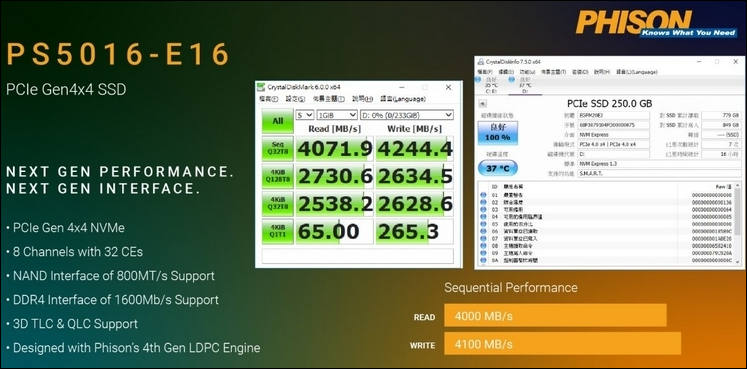
It allows to keep PV going, with more focus towards AI, but keeping be one of the few truly independent places.
-
PS5 dev kit specs
- Monolithic die ~22.4mm by ~14.1mm custom LSI with Zen 2 CPU + Navi GPU (weakest part of all!)
- 32GB GRRD6 - 16 Samsung K4ZAF325BM-HC18 in clamshell configuration
- 6GB DDR4 for cache and such - 3 Samsung K4AAG085WB-MCRC, 2 of those close to the NAND acting as DRAM cache (unusual 2GB DRAM per 1 TB NAND)
- 4 NAND packages soldered to the PCB which are TH58LJT2T24BAEG from Toshiba
- 2TB SSD that uses PCIe 4.0 controller PS5016-E16 from Phison


 sa8379.jpg747 x 369 - 53K
sa8379.jpg747 x 369 - 53K -
Xbox Project Scarlett, release in Holiday 2020
- AMD's Zen 2 CPU + Navi Graphics (previous leak suggest 8 core CPU that is quite low power)
- GDDR6 memory (up to 22GB 352bit bus)
- Fast NVMe SSD also used for virtual RAM
- Will have ray tracing (most probably it is marketing only!)
- 8K support (marketing only!), 1080 120fps and even may be 4k 120fps.
- Streaming services will be a big part of the console
- You won't be being able to resell games you bough
- Big role of rented games, can be that most games will be provided on subscription/rental scheme only
- Microsoft don’t have any plans for VR support, SOny also likely will drop their headset support
From the start consoles will be extremely underpowered compared to most good PCs, only advantage will be more RAM available for GPU. So if you intend to play new games look no less than 11GB for your next GPU and it'll be ok.
-
Some leak of Xbox specs
Scarlett Devkit ( Dante ) Preview.1
- Rev.1 Production in Oct 2019.
- Final version around Aug 2020.
- Preview.1 built-in Chuckwalla case.
- SOC: Anubis ( 393mm2 )
- CPU: Custom Zen 2, 8 Cores 16 Threads @ 3.4GHz Built-in with DirectX 12.X, DXR, DirectML and Havok instructions into the chip.
- GPU: Custom Navi 21, Full 56 Compute Units @ 1623MHz
- RT: 1 RTC per Compute Unit
- RAM: 48GB GDDR6 @ 560GB/s
- STORAGE: 1TB+4TB SSD NVMe PCIe 4.0 @ 4GB/s, Flexible Dedicated vRAM starts with 32GB ( Up-to 64GB )
- AUDIO: Custom Tensilica HIFI DSP
- I/O: 2x HDMI 2.1, 4x USB-C ( Thunderbolt ), 2x USB-A, 2x RJ-45, 1x S-PDIF, 1x IR-OUT, Bluetooth 5.0, WIFI * Direct, WIFI IEEE 802.11ax
- API: DirectX 12.X, DXR, DirectML
- PSU: 275W
Scarlett ( Retail )
- Targeting Performance.
- Final version around Aug 2020.
- SOC: Anubis ( 393mm2 )
- CPU: Custom Zen 2, 8 Cores 16 Threads @ 3.4GHz Built-in with DirectX 12.X, DXR, DirectML and Havok instructions into the chip.
- GPU: Custom Navi 21, 52 Compute Units @ 1623MHz
- RT: 1 RTC per Compute Unit
- RAM: 24GB GDDR6 @ 560GB/s ( Samsung 12x2GB ), 18GB GDDR6 + 2GB GDDR6 Cache + 32GB~64GB SSD vRAM ( Up-to 84GB for Game ) and Dedicated 4GB GDDR6 for OS ( Native 4K60/120FPS Dashboard )
- STORAGE: 1TB SSD NVMe PCIe 4.0 @ 4GB/s, Flexible Dedicated vRAM starts with 32GB ( Up-to 64GB )
- AUDIO: Custom Tensilica HIFI DSP
- I/O: 2x HDMI 2.1, 2x USB-C ( Thunderbolt ), 2x USB-A, 1x RJ-45, 1x S-PDIF, 1x IR-OUT, Bluetooth 5.0, WIFI Direct, WIFI IEEE 802.11ax
- API: DirectX 12.X, DXR, DirectML
- PSU: 275W
So, as we can see - it will be quite weak. SSD most probably will be QLC to maximally save on costs.
4GB now required for dashboard and stuff, huh. Quality of modern developers.
At peak it will consume 250 Watts and it is extremely low, as same 3700X overclocked consumes around 150 Watts, same is true for graphical system. Most probably here we will see first time same approach with notebooks - software will throttle things and all real performance will be restricted by thermal package and not real hardware limits.
Howdy, Stranger!
It looks like you're new here. If you want to get involved, click one of these buttons!
Categories
- Topics List23,992
- Blog5,725
- General and News1,354
- Hacks and Patches1,153
- ↳ Top Settings33
- ↳ Beginners256
- ↳ Archives402
- ↳ Hacks News and Development56
- Cameras2,367
- ↳ Panasonic995
- ↳ Canon118
- ↳ Sony156
- ↳ Nikon96
- ↳ Pentax and Samsung70
- ↳ Olympus and Fujifilm101
- ↳ Compacts and Camcorders300
- ↳ Smartphones for video97
- ↳ Pro Video Cameras191
- ↳ BlackMagic and other raw cameras116
- Skill1,960
- ↳ Business and distribution66
- ↳ Preparation, scripts and legal38
- ↳ Art149
- ↳ Import, Convert, Exporting291
- ↳ Editors191
- ↳ Effects and stunts115
- ↳ Color grading197
- ↳ Sound and Music280
- ↳ Lighting96
- ↳ Software and storage tips266
- Gear5,420
- ↳ Filters, Adapters, Matte boxes344
- ↳ Lenses1,582
- ↳ Follow focus and gears93
- ↳ Sound499
- ↳ Lighting gear314
- ↳ Camera movement230
- ↳ Gimbals and copters302
- ↳ Rigs and related stuff273
- ↳ Power solutions83
- ↳ Monitors and viewfinders340
- ↳ Tripods and fluid heads139
- ↳ Storage286
- ↳ Computers and studio gear560
- ↳ VR and 3D248
- Showcase1,859
- Marketplace2,834
- Offtopic1,320




